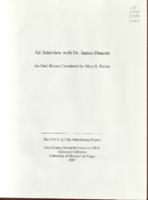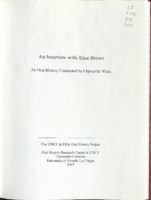Search the Special Collections and Archives Portal
Search Results
Cockrum, Steve, S1, T22, R60, 2.5 acres, 5 miles SW of Las Vegas Strip, 1978
Level of Description
File
Archival Collection
Elmo C. Bruner Architectural and Real Estate Appraisal Records
To request this item in person:
Collection Number: MS-00177
Collection Name: Elmo C. Bruner Architectural and Real Estate Appraisal Records
Box/Folder: Box 39
Collection Name: Elmo C. Bruner Architectural and Real Estate Appraisal Records
Box/Folder: Box 39
Archival Component
Cannon Mortgage Company, SW 1/4, S4, T22S, R61E, Highway 91, south of McCarran Field, 1961
Level of Description
File
Archival Collection
Elmo C. Bruner Architectural and Real Estate Appraisal Records
To request this item in person:
Collection Number: MS-00177
Collection Name: Elmo C. Bruner Architectural and Real Estate Appraisal Records
Box/Folder: Box 10
Collection Name: Elmo C. Bruner Architectural and Real Estate Appraisal Records
Box/Folder: Box 10
Archival Component
The Monthly Mirror: reflecting men and manners, vol. 22, no. 133. London: printed by J. Wright, 1806 November
Level of Description
Item
Archival Collection
Mavis Eggle "Books as They Were Bought" Collection
To request this item in person:
Collection Number: MS-01144
Collection Name: Mavis Eggle "Books as They Were Bought" Collection
Box/Folder: Box 02
Collection Name: Mavis Eggle "Books as They Were Bought" Collection
Box/Folder: Box 02
Archival Component
#69738: UNLV Boyd School of Law Professor Ann McGinley poses with students Michael Lin (in purple) and Elizabeth Wo Do (in black) as well as with a large group of local attorneys during a photo session May 22, 2014 at the University of Nevada, Las Vegas, 2014 May 22
Level of Description
File
Archival Collection
University of Nevada, Las Vegas Creative Services Records (2010s)
To request this item in person:
Collection Number: PH-00388-05
Collection Name: University of Nevada, Las Vegas Creative Services Records (2010s)
Box/Folder: Digital File 00
Collection Name: University of Nevada, Las Vegas Creative Services Records (2010s)
Box/Folder: Digital File 00
Archival Component
Boulder Dam. Note 10-foot diameter powerhouse gallery forms being installed: photographic print, 1933 November 22
Level of Description
Item
Archival Collection
Six Companies, Inc. Hoover Dam Photograph Collection
To request this item in person:
Collection Number: PH-00267
Collection Name: Six Companies, Inc. Hoover Dam Photograph Collection
Box/Folder: Oversized Box 02
Collection Name: Six Companies, Inc. Hoover Dam Photograph Collection
Box/Folder: Oversized Box 02
Archival Component
Prime Rewards ERS Files, table top 4 x 6, poster 22 x 28, duratrans 24 x 36, slot topper, undated
Level of Description
File
Archival Collection
Stardust Resort and Casino Records
To request this item in person:
Collection Number: MS-00515
Collection Name: Stardust Resort and Casino Records
Box/Folder: Box 040
Collection Name: Stardust Resort and Casino Records
Box/Folder: Box 040
Archival Component

Transcript of interview with Julie Brinkerhoff-Jacobs by Stefani Evans, September 30, 2016
Date
2016-09-30
Archival Collection
Description
When Julie Brinkerhoff-Jacobs talks about the landscape architecture firm her parents, Barbara and Don Brinkerhoff, began in their home in 1958, she brightens and leans in. Since joining her parents’ firm in 1982, Julie gradually assumed responsibility for Lifescapes International’s sales, marketing, financial management, and strategic planning and serves as President and Chief Financial Officer. Here, Brinkerhoff-Jacobs talks of her life before joining and outside of Lifescapes: her family; her youth; her charity, HomeAid; her leadership activities; and her personal interests. Her focus, though, is Lifescapes and the Las Vegas people and the iconic projects that not only altered the ways that visitors perceive Southern Nevada but also changed the business of Lifescapes. “Not just in Las Vegas, but around the world people hire us because of what we've done in Las Vegas.” For Julie, one of the greatest joys of working alongside her parents was discovering them as peers—learning to know them as two people who “chose to live an incredibly artistic life together.” Her mother passed in 2014, but Julie and her father continue to work with and learn from each other.
Text
#68585: Flower on campus taken for the possible use in the Boyd Law School art project April 28, 2012 at the University of Nevada, Las Vegas, 2012 April 28
Level of Description
File
Archival Collection
University of Nevada, Las Vegas Creative Services Records (2010s)
To request this item in person:
Collection Number: PH-00388-05
Collection Name: University of Nevada, Las Vegas Creative Services Records (2010s)
Box/Folder: Digital File 00
Collection Name: University of Nevada, Las Vegas Creative Services Records (2010s)
Box/Folder: Digital File 00
Archival Component

Transcript of interview with Dr. James Deacon by Mary K. Keiser, August 24, 2006
Date
2006-08-24
Archival Collection
Description
James Deacon was born at home in White, South Dakota. For the first few years of his life, the family moved around a lot to accommodate his father's job as school superintendent. Their summers were spent in a cabin on a lake, where Jim helped his grandparents in their store, seining minnows, clerking, and putting up ice. From his eighth grade year through high school graduation, the family lived in Aberdeen, which was the largest city (population 25,000) they had lived in Jim attended college on a tuition scholarship in Wichita Falls, Texas. He majored in biology and education, and then went to grad school at the University of Kansas. His favorite undergraduate professor knew the fish expert there and encouraged Jim to study fish. Instead of completing a master's degree, Jim went straight into the Ph.D. program. He graduated in the summer of 1960, and started applying for jobs. He interviewed with Dean Bill Carlson for a job at UNLV, which was then called University of Nevada Southern Regional Division. In 1964, Jim and his family moved to Reno and he taught two summers at UNR. As professor of biology, Jim focused on getting students involved in field studies as well as classroom work. He was instrumental in organizing the Department of Environmental Studies, which started in 1992. He also helped develop a master's program and a Ph.D. program in biology. He is best known for his expertise and involvement in the study of the Devil's Hole pup fish, an endangered Nevada species of fish.
Text

Transcript of interview with Alice Brown by Claytee D. White, October 19, 2005
Date
2005-10-19
Archival Collection
Description
Alice Brown, former UNLV librarian, was born in Cleveland, Ohio. She gives a thorough and fascinating history of her family going back to the 1600s and includes a detailed description of the family home, which may have served as a stop on the antislavery Underground Railroad. Alice attended college in Pennsylvania and earned a library degree at Carnegie. After Pearl Harbor, she enlisted in the Women's Army Auxiliary Corps and served in the U S. and overseas. Upon discharge from the Army, she worked as assistant children's librarian in Cleveland Heights for a time and then followed a friend out to Tacoma, Washington. She worked in the Tacoma Public Library as children's librarian, and also met her husband there. Alice's husband was offered a job in Henderson, Nevada, at the manganese plant. That didn't work out, but he was hired at Titanium right away. Alice describes Henderson as it was in the fifties, and also discusses the state of the libraries in both Henderson and Las Vegas. After the birth of her third child, Alice began working at the University of Nevada Southern Regional Division (now UNLV) part time. This was in 1962, and Alice shares detailed memories of the university campus, library, and faculty and staff from that era. Alice did not slow down after her retirement in 1985. She did volunteer work, traveled, and attended classes at UNLV. Today she volunteers at the Clark County Heritage Museum as a cataloger and at the hospital helping deliver papers and lab work to their various destinations.
Text
Pagination
Refine my results
Content Type
Creator or Contributor
Subject
Archival Collection
Digital Project
Resource Type
Year
Material Type
Place
Language
Records Classification
